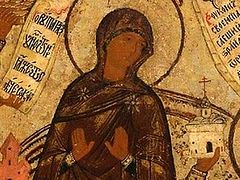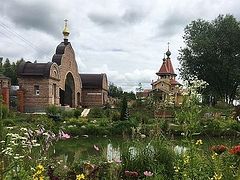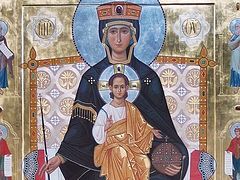The Russian nation has from ancient times found in its soul a true word in addressing the Theotokos; they have always and still call her their own mother. The expression they use is filled with tenderness and love: “Matushka!” People have spiritually felt not in an allegorical sense, but as a supremely ontological reality that the Mother of God is the Mother of the Church—by blood, as in the Blood of Christ, She is the Mother of every Christian. —Archpriest Lev Lebedev.
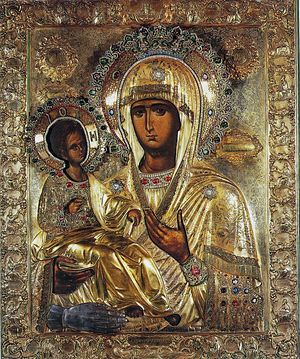 The icon of the Mother of God of the “Three Hands” The event that placed a beginning of the glorification of the “Three Hands” icon of the Mother of God dates to the eighth century, to the times of iconoclasm. Soldiers of the heretic-emperor Leo the Isaurian ransacked the homes of Orthodox Christians in search of icons, confiscated them and burned them, and put those who venerated icons to torture and death.
The icon of the Mother of God of the “Three Hands” The event that placed a beginning of the glorification of the “Three Hands” icon of the Mother of God dates to the eighth century, to the times of iconoclasm. Soldiers of the heretic-emperor Leo the Isaurian ransacked the homes of Orthodox Christians in search of icons, confiscated them and burned them, and put those who venerated icons to torture and death.
Only outside the boundaries of the Byzantine lands, in Moslem Damascus, the Orthodox were not repressed for their veneration of icons. The reason for this was that the chief minister of the local caliph was a zealous Orthodox Christian, theologian, and hymnographer—St. John of Damascus (commemorated by the Church on December 4/17).
St. John sent letters to his numerous friends in Byzantium, in which he proved, based on Holy Scripture and patristic tradition, the correctness of the veneration of icons. John Damascene’s inspired letters were passed along from hand to hand—and played no small role in convincing the Orthodox people of the truth, and exposing the heresy of iconoclasm.
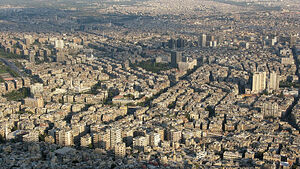 Damascus, a modern view The maddened emperor wanted to deprive the Church of this invincible defender of Orthodoxy, and so decided to remove John Damascene by cunning. He ordered experienced scribes to carefully study St. John’s handwriting and then write as if from his hand a fraudulent letter to the emperor with an offer of treason. In the letter there was information that since the city of Damascus is negligently guarded by Saracens, the Byzantine forces could take it with ease, and that on his part, the chief minister promised every assistance.
Damascus, a modern view The maddened emperor wanted to deprive the Church of this invincible defender of Orthodoxy, and so decided to remove John Damascene by cunning. He ordered experienced scribes to carefully study St. John’s handwriting and then write as if from his hand a fraudulent letter to the emperor with an offer of treason. In the letter there was information that since the city of Damascus is negligently guarded by Saracens, the Byzantine forces could take it with ease, and that on his part, the chief minister promised every assistance.
The emperor sent the fraudulent letter to the caliph, hypocritically explaining that despite John’s offer, he desires peace and friendship with the caliph, but advises him to punish his treasonous minister.
The caliph was enraged, and forgetting the many years of his minister’s faithful service, he ordered the severance of John’s right hand, with which he had supposedly written the treasonous lines. The severed hand was hung on the market square for all to see.
John suffered cruelly from the pain, and even more from the undeserved punishment. Toward evening he asked the caliph to allow him to bury his severed right hand. Remembering his minister’s former zeal, the caliph consented.
Secluded in his home, John Damascene placed the hand to the wound and immersed himself in prayer. The saint asked the Mother of God to heal his right hand, which had written in defense of Orthodoxy, and he made a vow to use the hand to create a work in honor of the Sovereign Lady.
At that moment he fell asleep. In a dream he saw the Mother of God, who came to him and said, “You are healed; labor zealously with this hand.”
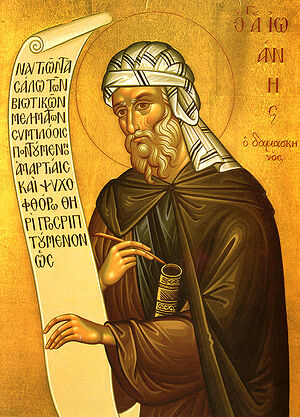 St. John Damascene When he awoke, John Damascene poured out his gratitude to the miraculous Healer in the wonderful hymn, “All of creation rejoices in Thee, o Thou Full of Grace…” Word of the miracle quickly spread throughout the city. The ashamed caliph asked John Damascene for forgiveness and called him to return to his work of state governance, but from then on John gave all his strength to the service of the one God. He departed to the monastery of St. Savva the Sanctified, where he received the monastic tonsure. The saint brought there the icon of the Mother of God that had brought him healing. In memory of miracle he affixed to the lower part of the icon an image of his right hand, made of silver.
St. John Damascene When he awoke, John Damascene poured out his gratitude to the miraculous Healer in the wonderful hymn, “All of creation rejoices in Thee, o Thou Full of Grace…” Word of the miracle quickly spread throughout the city. The ashamed caliph asked John Damascene for forgiveness and called him to return to his work of state governance, but from then on John gave all his strength to the service of the one God. He departed to the monastery of St. Savva the Sanctified, where he received the monastic tonsure. The saint brought there the icon of the Mother of God that had brought him healing. In memory of miracle he affixed to the lower part of the icon an image of his right hand, made of silver.
To this day, this right hand is depicted on all copies of this miraculous icon, which has received the name, “Three Hands”.
The icon remained in the monastery of St. Savva until the thirteenth century, when it was brought to another St. Savva, the Archbishop of Serbia. When the Hagarenes advanced also on Serbia, the Orthodox people placed the icon on a donkey and released it unaccompanied. The donkey arrived with its precious load at Holy Mt. Athos and stopped at the gates of Hilandar Monastery.1 The local monks received the icon as a great gift, and every year since they have made cross processions to the place where the donkey stopped.
Once in Hilandar Monastery, the elderly abbot reposed. The election of a new abbot caused arguments and division among the brethren. Then the Mother of God appeared to one recluse and announced that from then on, she herself would be the abbess of the monastery. As a sign of this, the “Three Hands” icon, which had always been in the altar of the monastery cathedral, was transported through the air to the center of the church, to the abbot’s place. From that time on, Hilandar Monastery has been ruled by a hieromonk-vicar, who stands during the service at the abbot’s place, where the “Three Hands” icon, the Abbess of that monastery, is kept. The monks venerate the icon and receive their blessing from it, as from the abbot.
During the Greco-Turkish wars, Mt. Athos was outside the authority of the non-Orthodox; the Turks have admitted that they often saw a mysterious Lady guarding the walls of Hilandar Monastery, unreachable by human hands.
The “Three Hands” icon has long been venerated also in Russia, where there are many copies of the original image, which are likewise known as miraculous. Already in 1651, the monks of Hilandar sent one such copy as a gift to the New Jerusalem Monastery.2 Another copy was made from this copy, and is still kept in the Moscow Church of the Dormition in Gonchary (the Bulgarian representation church). It is considered that by the intercessions of the Mother of God through this icon, this church was never closed even during the fiercest persecutions against the Church, and all of its bells are still there. Now an Akathist is sung every Friday before the icon in that church. There is another copy of the same icon in a tile encasement on the outside wall of the Church of the Dormition in Gonchary, and unceasing prayers can be heard before this icon of the Mother of God of the “Three Hands”.
Miraculous copies of the original Mt. Athos icon were also located in Moscow Church of the Protection in Goliky, in the Tula Church of the Vladimir Icon on the Rzhavsta, in the Beloberezhskaya Monastery near Bryansk, in the Voronezh St. Alexis Akatovo Monastery, in the St. Nilus of Stolbensk Monastery on Lake Seliger, and in other places.

